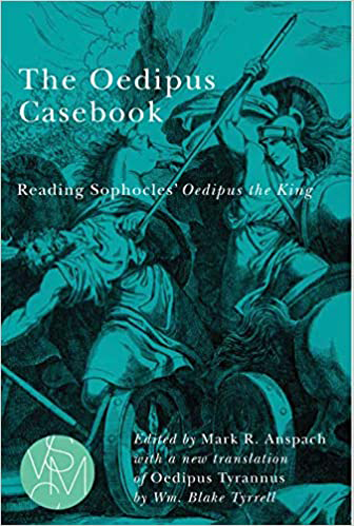
‘Who killed Laius? Most readers assume Oedipus did.’ With this enticing hook on the cover of his hefty volume, Mark R Anspach invites us into this volume. Framing Oedipus The King as a ‘murder mystery’ which is still up for debate gives Anspach the basis for presenting both William Blake Tyrell's new translation and 14 articles or selections from books by a broad range of critics.
Tyrell's translation is useful and interesting. First, it is presented as a parallel text alongside the established Greek text of H. Lloyd-Jones and N.G. Wilson. One note is that the Greek text itself uses a lunate sigma. The translation keeps as closely as possible to each line, rendering the Greek as literally as possible.
At times the literal nature of the translation can be a challenge in understanding colloquial moments of Greek (e.g. line 44f includes the baffling line: ‘I have seen that for men of experience the outcome / of their counsels also proves especially alive.’ or line 653 ‘respect him as someone large in his oath’ or line 950 ‘O dearest head of my wife, Jocasta.’) As a teacher of the Greek text, or even examining the English meaning with reference to the Greek, this is incredibly useful even if, at times, more translator's notes would have been welcome. Moreover, notes would have been helpful to explain curious choices such as where the translation vacillates in translating daimōn as ‘god’ and ‘daimon’ interchangeably.
The notes that are provided are tremendously helpful and scholarly, often pointing out elements in the drama, rather than explanations of the translation itself. One further delight is the use of a paler grey text both in the Greek and in the relevant translation where there is a contested reading and where the word is irreparable and so the meaning is tentative.
William Blake Tyrrell has opted to side with a traditional translation that often uses old-fashioned language. The opening line: ‘O children, newest of ancient Cadmus’ brood’ is a case in point. But the intimate connection between Greek and English makes significantly easier the task of deciphering the Greek. This is a translation to help someone study the text rather than one to perform from.
The rest of the book is divided up into three parts containing the articles and a concluding, useful index that allows thematic ideas to be looked up across the articles.
The first part, entitled ‘The Ritual Background’, includes three articles (none published more recently than the 1980s) which discuss the ritual of the ‘scapegoat’ and its relationship with kingship, religion and exposed children. They provide a good background for anyone with a hazier understanding of these rituals.
The second part consists of five articles, including one of Anspach's own, where he comments extensively on the second article by Girard (Anspach's own key area of interest): ‘Oedipus and the Surrogate Victim’. This section also includes an interesting perspective from Terry Eagleton (from his Sweet Violence) and Jean-Pierre Vernant's wonderful ‘Ambiguity and Reversal: On the Enigmatic Structure of Oedipus Rex’. Helen Peet Foley's article connects Oedipus as the scapegoat and intriguingly touches on aspects of political ideas and ideals (which are of course relevant to the Classical Civilisation A Level specification).
Part 3, entitled ‘Oedipus on Trial’, explores more of the social and legal situation, picking up on Anspach's initial tantalising suggestion that Oedipus was not in fact responsible for the murder of Laius and leaving absolutely no sandwich undigested in this smorgasbord of incrimination (including, the chorus itself!). I enjoyed these articles, feeling that they were, for the most part, really interesting and well chosen. However, I found Sandor Goodhart's post-structural article densely opaque and obscurely expressed and while many of the other articles might be suitable – at least in part – for bright A Level students, this stretched my tolerance. Goodhart also devotes five pages to examining Gilbert Norwood's examination of Oedipus the King in ‘Greek Tragedy’ (NY Hill & Wang 1960), which was not published in this edition and ends with an over-extrapolated conclusion that we (the critics / audience) become ‘Oedipal’. Having forced myself to read Girard's article, I was not in the mood to be impressed and it took all of Frederick Ahl's lucid prose and intelligence in the final article in the book, to restore my humour.
To conclude: this is a very useful tome that I will certainly be drawing on in my teaching of Classical Civilisation for inspiration, ideas and when I need a really close translation.




